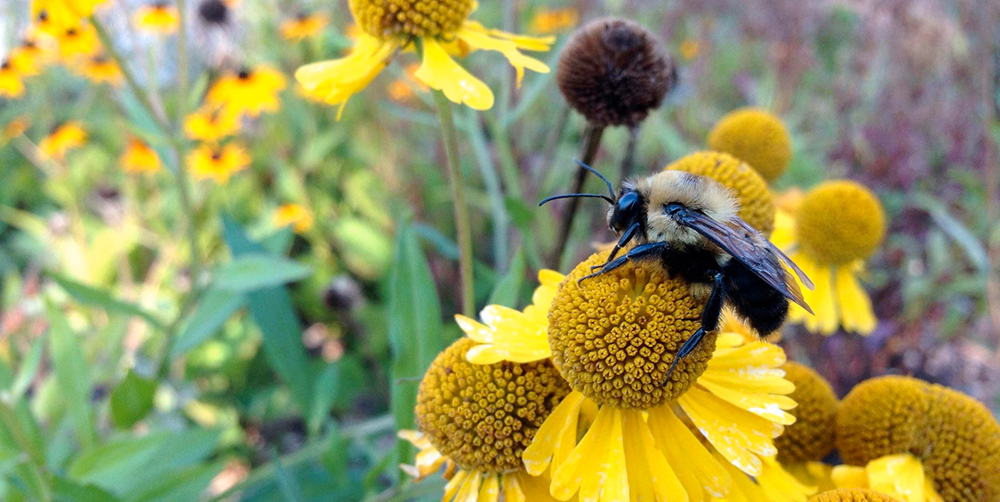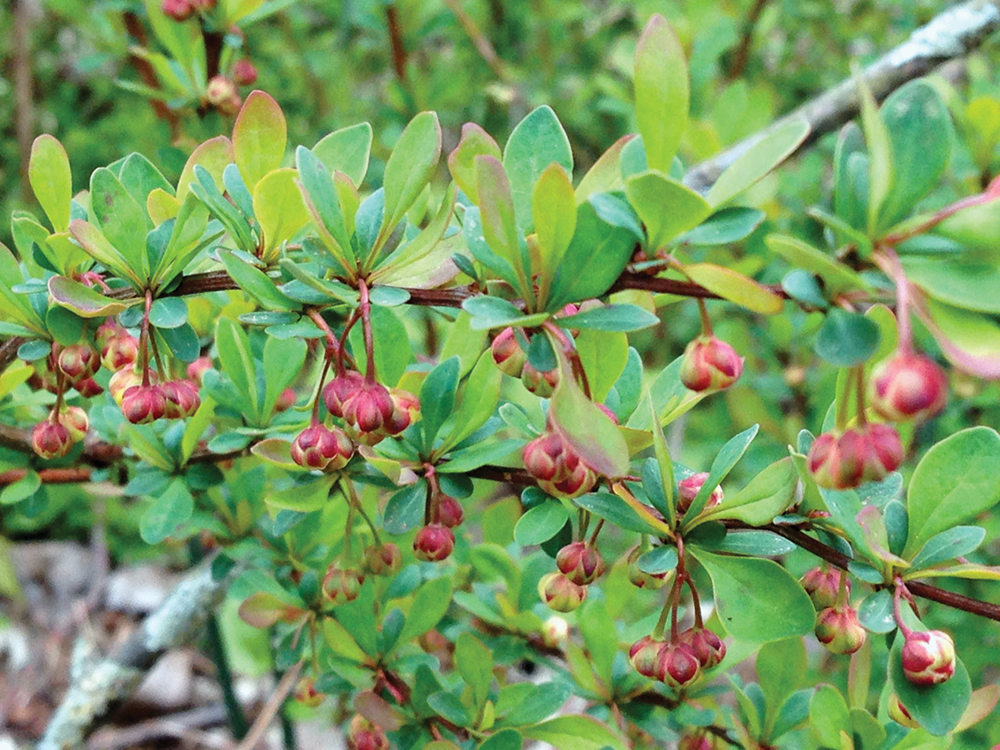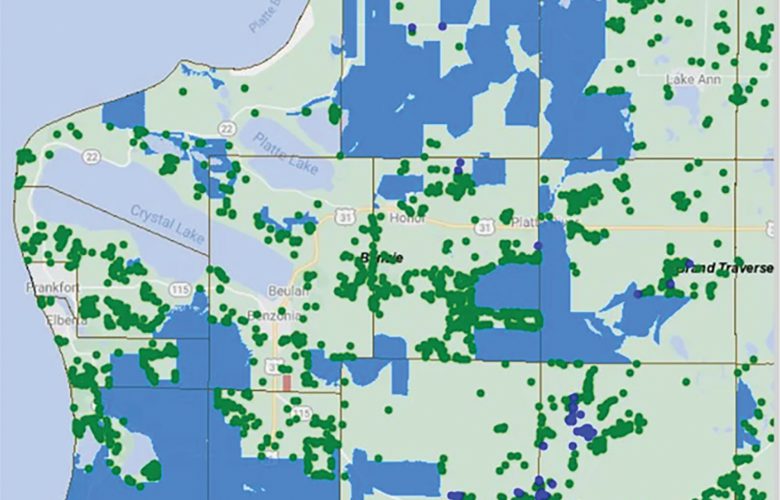Japanese barberry has become one of Northern Michigan’s least-wanted plants
By Emily Cook
Current Contributor
The arrival of spring is a time when many of us reflect upon our yards, visiting local garden stores in search of “something new” to add to our personal landscapes. But spring is also a time in which we can be mindful of what we should be removing, as well.
Once introduced to a new location, invasive species have a tendency to spread, because there are no natural predators in that new location, like there typically are in the places where these plants originally came from—this idea of checks and balances in nature is one of the fundamentals of any high school biology class.
For this reason, non-native species can quickly drive out native species; in a few short years, the local ecosystem which has existed for millennia can soon become endangered.
Author Elizabeth Lawrence once wrote: “The hum of bees is the voice of the garden.” That quote, while full of summertime imagery, touches on an important message of creating a landscape that is appealing to our pollinators, the incredibly important insects—not to mention birds, bats, and small mammals—that support so many other living things on this planet, humans included.
Bees and butterflies are some of the most commonly known pollinators. They are flitting among plants and doing more than just moving pollen grains; they are also seeking plants to eat and upon which they can lay their eggs.
Research shows that native plants are preferred by most insects, especially pollinators. In fact, Doug Tallamy, a professor of entomology and wildlife ecology at the University of Delaware and author of Bringing Nature Home, has found that native plants support hundreds more insect species than some of the non-native species which often get incorporated into our gardens.
There is an entire list of dozens of invasive plant species that can be found in Northern Michigan—to name just a few that The Betsie Current has reported on over the years: garlic mustard (Alliaria petiolata) that was originally brought here in the mid-19th century from Europe and parts of Asia for food and medicinal purposes is now crowding out native wildflowers along many forest beds; baby’s breath (Gypsophila) that is often included in wildflower seed mixes, with each individual plant capable of producing 14,000 seeds each year, is quickly taking over our beaches and dunes; and purple loosestrife (Lythrum salicaria) that has a vast and intertwined root system, which overpowers local wetlands.
Whereas invasive plant species are always a threat to native plants and to the fauna who feed upon them, there is one non-native plant to which we should all be paying particular attention, because it has become a threat to human life, too—in Northern Michigan, Japanese barberry (Lythrum salicaria) is a plant that is preferred by blacklegged ticks (Ixodes scapularis), the primary host of Lyme disease.
A Growing Tick Problem
Appealing because of its hardy nature, red berries, and resistance to deer (due to some particularly long thorns), Japanese barberry is classified as an invasive species, because it spreads voraciously past garden boundaries and into nearby natural areas, thereby displacing native plants and reducing wildlife habitat. But beyond simply affecting pollinators, invasive barberry goes a step further and plays host to a very unwanted critter—the blacklegged tick—which takes this invasive plant issue beyond just an ecological matter and into the realm of public health.
Of the more than 20 Michigan tick species, three are common to Benzie County. It is the blacklegged tick—one of the smaller ticks—that is the known carrier of Lyme disease, as well as other diseases.
Ticks proliferate in the spring and summer and hang around into the fall during Indian summers. Spring is an especially active time for ticks, because the weather is damp and the nymphs are emerging from winter; they are ready to begin active feeding, which can last up to five days once a tick attaches itself to a host.
Most ticks prefer wildlife, but the blacklegged tick is one of several species that will also sink its ferocious mouthparts into people and domestic animals. While it spends several days feasting on the blood of its generous and unaware host, the tick may also be transmitting the bacteria that causes Lyme disease. Research suggests that a blacklegged tick must latch onto its host for at least 24 hours before the disease-producing organism can be transmitted.
“There has been a slight increase of confirmed Lyme disease cases [here] over the past several years,” says Michelle Klein, director of personal health at the Benzie-Leelanau Health Department. “I would say the numbers have actually doubled when one includes probable cases, but the disease is not easy to diagnose, as the initial symptoms can be so vague.”
Lyme disease is an epidemic bacterial infection that lacks effective treatment. Prompt diagnosis is critical but not always possible. Antibiotics are the choice treatment and are most effective in early diagnosis. If the disease becomes chronic or is left untreated in its early stages, it often requires more intensive and long-term treatment—sometimes as long as two to three years.
Short-term symptoms can occur within three to 30 days after exposure and include chills, fever, and aching muscles and joints, much like the flu. Long-term symptoms, meanwhile, may mimic a host of degenerative neurological diseases, such as multiple sclerosis, Parkinson’s, and Alzheimer’s. Multi-system involvement migrates to different parts of the body, causing body aches, joint pain, headaches, fatigue, confusion, and heart problems.
Klein advises not waiting for test results to confirm Lyme disease if flu-like symptoms develop after being bitten. Rather, seek prompt attention from your healthcare practitioner.
Also be on the look-out for ticks on your pets.
“Domestic cats are not prone to Lyme disease, but dogs are,” says Susan Daly, a veterinary medical doctor at the Betsie River Veterinary Clinic in Benzonia. Daly says that pets can be screened with a blood test in the office. If treated in the acute phase of two weeks to two months after a bite, the dog’s disease can be cured with antibiotics. There is also a vaccine that can be administered preemptively.

Increasing Threat
The Betsie Current first reported on Lyme-carrying ticks in Benzie County back in 2014 and 2015. Sadly, since that time, Benzie County remains on the updated 2019 Michigan Lyme Disease Risk Map as one of the many Michigan counties with laboratory-confirmed populations of infected blacklegged ticks—and the number of counties has increased from 25 to 37 since 2014.
It would appear, however, that Benzie County is one of the luckier areas, with 10 confirmed cases over the past five years. Meanwhile, Dickinson County (near Marquette, in Michigan’s Upper Peninsula) has had 142 cases, and Berrien and Kalamazoo counties (in the state’s southeast corner) have had 123 and 83 cases, respectively, according to a Single Disease report, provided by Klein.
Of course, these figures do not include the other members of one’s family—our pets. This spring has seen dog cat owners removing an alarming number of ticks.
Some, like Miriam Owsley of Leelanau County, are avoiding certain areas completely.
“I am cautious when it comes to recreating outside,” she says. “Although I protect my dog with tick and flea medications and she is up to date on her Lyme vaccine, I often opt against walking on wooded trails, because of the risk of bringing the pests into my home.”
Experts advise avoiding wooded and brushy areas, as well as high grassy meadows, where hitchhiking ticks wait for an opportunity. After returning home, hikers should perform a “tick check” that focuses on the scalp and ears, back, belly button, waist, pelvic and groin area, and behind the knees—ticks will migrate to these warm regions of the body from wherever they first hopped aboard.
What Can Be Done?
A recent study conducted by the University of Connecticut found that the umbrella shape of Japanese barberry plants created a perfect, humid environment for ticks. The study’s results speak for themselves—in areas that are dense with barberry, 120 Lyme-infected ticks were found; there were 40 infected ticks per acre where barberry was present, and only 10 ticks where there was no barberry.
The Northwest Michigan Invasive Species Network (ISN) and its partners are discovering more and more stands of dense barberry that have escaped cultivation. Taking over the understory of many forests—combined with the already alarming numbers of ticks in the region—Japanese barberry is quickly becoming a higher priority on the list of invasive species.
Because of this, homeowners and property managers are encouraged to remove their barberry and, if possible, to replace it with a non-invasive alternative. Good alternatives include shrubs like ninebark (Physocarpus), New Jersey Tea (Ceanothus americanus), and shrubby cinquefoil (Dasiphora fruticosa). Ninebark especially can look quite similar to barberry but will not spread, and it serves as a great host for pollinators.
How to Identify Ticks and Protect Yourself
May is Lyme Disease Awareness Month in Michigan, and awareness is definitely key to prevention.
- According to Michelle Klein from the Benzie-Leelanau Health Department: “A deer tick needs to be attached for at least 24 hours for the disease to be transmitted. And even then, less than 10 percent of people will get Lyme disease.”
- If you have an attached tick, a photo can be sent to the State of Michigan Health Department (Michigan.gov/MDHHS) for identification.
- You can also visit TickEncounter.org to identify on your own.
- Only live ticks can be tested for Lyme disease. Please contact your local health department for instructions on how to do so. (Since tick species are best identified by an expert, save it in a sealed plastic bag with a damp paper towel, and take it—preferably alive—to the local health department. For more information, contact the Benzie-Leelanau Health Department at 231-882-4409.)
- When recreating, wear long pants and use bug spray. A good body check is critical, and having someone to look on your back is very helpful.
- If you are showing early symptoms of Lyme disease—fatigue, itchy and achy joints, headaches, night sweats, cognitive decline—go to your doctor and tell her/him that you either had an attached tick at one point or have had exposure to deer ticks in the past.
This summer, ISN is providing several opportunities to swap out the invasive for the native, via their Japanese Barberry Trade-up Days. Hosted at the Boardman River Nature Center in Traverse City on Friday, June 7, and at Grow Benzie on Saturday, June 22, individuals can bring in their removed barberry to be disposed of correctly.
While barberry can be disposed of at home, Michigan law requires certain parameters to be followed which includes double bagging each plant. This can become cumbersome and cause issues with waste collectors. Having an option to dispose of the plant in bulk simplifies the process and reduces bag waste, so ISN encourages individuals to bring their barberry in to a trade-up day.
As a bonus, in exchange for each returned plant, ISN will provide a coupon to a local nursery that can be applied toward a native plant—a value up to $50. This will ensure that any replacement plant will be non-invasive and will support an array of wildlife and pollinators. Participating businesses include: Greystone Gardens between Honor and Empire, Misty Ridge Greenhouse in Mesick, Birdsfoot Native Nursery in South Boardman (between Kalkaska and Fife Lake), Garden Goods Nursery, The Mossy Tree, Pine Hill Village Gardens, and Wildlife and Wetland Solutions of Traverse City.
As we begin to emerge into our gardens after the long winter and to explore the shelves of our local garden centers, perhaps Elizabeth Lawrence’s quote should be modified to: “The hum of the bees, the songs of the birds, and the diving of bats are the voices of the native garden.”
Emily Cook is ISN’s outreach specialist. If you want to trade in your Japanese barberry, pre-registration is required and can be found online at HabitatMatters.org. Any questions can be directed to 231-941-0960 extension 20 or ecook@gtcd.org.
Top Photo Caption: Appealing because of its hardy nature, red berries, and resistance to deer, Japanese barberry is classified as an invasive species, because it spreads into nearby natural areas. But barberry also is host to Lyme-disease-carrying blacklegged ticks, which takes this invasive plant issue beyond just an ecological matter and into the realm of public health. Photo courtesy of the Northwest Michigan Invasive Species Network (ISN).




